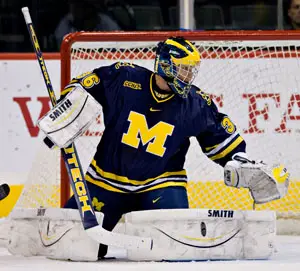Its natural for fans and media to look way too deeply into what the coach of their team is doing. Exercising that right, let me throw this one at you for argument’s sake.
After getting blitzed at BU, Michigan coach Red Berenson went right back to senior goalie Billy Sauer in the Wolverines’ next game, a home tilt against Ohio State.
Berenson, in a conversation earlier this week, downplayed the significance of that by pointing out that Sauer and Bryan Hogan are rotating, with the only break in that rotation coming the week of the BU game as Hogan played a Thursday night home game against the defending CHA champions from Niagara while Sauer got the game at BU.

The purpose of assigning of Sauer to that game was to put the veteran goalie behind an injury-depleted defense corps in a pressure-cooker atmosphere like playing BU in Boston.
Sauer got shelled. He wasn’t terrible, but he didn’t deliver the marquee game you need your goalie to give you, especially in the first period of a road game. Hogan provided a little relief, but on that night BU looked very much like a team that would this week become the No. 1 team in the nation according to the USCHO.com/CBS College Sports poll.
That produced a good question for the staff at Michigan. The last two games Sauer played against top teams, the national semifinal against Notre Dame and the game at BU, he was pulled in both. Giving him a pass in the BU game because Michigan was a M*A*S*H unit on defense, you’d have to think that Michigan thought about starting Sauer on Friday for different reasons.
If I’m at the helm there (and I’ve faced this decision as a minor-league coach), I’m thinking about these questions.
Number one, do we start Sauer to show confidence and let him shake off last Saturday? He’s our guy, so let’s go right back to him. We’ve made a huge investment in him, we believe in him, we need to make sure he knows we have his back.
Number two, do we start him Friday at home because his last two games that he was pulled were both road games (ND was a neutral site, BU at Boston), or better termed, were away from Yost?
Number three, do we start him Friday because that was our plan, Sauer Friday and Hogan on Saturday?
Number four, do we not start him and start Hogan, because here comes OSU off a huge win at Denver and Hogan actually played fairly well at BU?
Red said Sauer got the start because of the rotation and he played well, especially early when the Buckeyes let it all hang out. It was a huge win for him because he played well, did what a number-one goalie needs to do, and most importantly, talk of a goaltending controversy.
Berenson likes the way his team is starting to play. Led by a dynamic sophomore class, Berenson’s hopes for a trip to Washington, D.C., in April hinge on goaltending because he’ll play the season without Mark Mitera, his top defenseman, and probably without Steve Kampfer, still recovering from a fractured skull. Sauer played well in a loss in Alaska, Hogan played well in a win at Alaska.
Is there a goaltending storm brewing in Ann Arbor? Berenson’s answer was an emphatic “no.”
“Bryan is 5-0. Billy is 2-3 but I can’t tell you that Hogan has played much better than Billy,” said Berenson. “We definitely have a goaltending competition here and that’s good. It makes them each better.”
On the topic of goaltending, Denver looks like it has another sensation in Marc Cheverie. A little unorthodox and a little scrambly at times, Cheverie has slammed the door on many occasions facing point-blank grade-A chances off the sticks of snipers from Colorado College, Ohio State, Minnesota Duluth, Wisconsin, and Notre Dame.
While the Pioneers are stacked well offensively, the back end is always key in the WCHA, and Cheverie belongs in the conversation with the elite ‘tenders in the conference like Richard Bachman, Alex Kangas, and Mike Zacharias.
Denver also has another success story on its hands in the form of defenseman Patrick Mullen. The son of Hall of Fame player Joe Mullen, Patrick was recruited as a forward but due to injuries a couple of seasons back, the Denver staff looked at their forwards and decided Mullen was the guy to step in for a while.
Now, according to his coach George Gwozdecky, he stands a notch ahead of former stars Matt Carle and Brett Skinner in terms of how well he skates as a backliner.
“You watch him pivot, change directions, accelerate, stop and start, cover ground, he’s the best of the three you mentioned,” said Gwozdecky as the Pioneers prepared to depart for a weekend series against St. Cloud. “Unlike Carle and Skinner, he didn’t grow up a defenseman learning the finer points of defending and playing the position.”
Then there’s Luke Salazar, a recruited walk-on from the North American Hockey League. Salazar has 6-5–11 in nine games and buries pucks like dogs bury bones. On a team with good balance offensively, Salazar has been put in a great position to succeed.
“He’s playing with a couple of older guys like Tyler Bozek, but he is just an unreal finisher. Don’t forget that he has always been a scorer. He has 41 goals last season in the NAHL,” said Gwozdecky. “His real strength is knowing where to find space, where to get to for passes and pucks. He has very good instincts.”
The scoring that was expected from Tyler Ruegsegger and Rhett Rakhshani hasn’t happened just yet, but Gwozdecky brought up a good point. Both players are wearing A’s this season, and the dual roles of playing and leading can slow players out of the gate as they get used to being more of an official focal point in the dressing room.
“I think they’ll both get it going as they move along,” said Gwozdecky. “They have each had a big goal the past two weekends. Once they pass through the transition of leadership, they’ll contribute more offensively.”
Which brings us to Michigan State and its leader, Jeff Lerg. He’s the goalie and he is the captain and that is one huge responsibility. I give Rick Comley a ton of credit here — this was a unique move. The reality is, there are two things in life you can count on: death and taxes. In East Lansing, Mich., you can count on death, taxes, and Lerg (a line I might have stolen from their fine SID, Jamie Weir).
In talking with Comley, the subject of leadership and goaltending came up, and how Lerg is handling the unique position.
“To this point he has been great with it,” said Comley. “We’ve been challenged to score with the early departures and the great seniors we lost. Jeff knows he has to be a rock for us. Where we worry is if he’ll try to do more verbally if we really start to struggle. It’s kind of like telling him that he can lead all week on the ice, but we’ll do it on game night.”
Quick Hits: To those who decried “eastern bias” when I opined that Boston was the best hockey city in America, especially those in Minnesota and North Dakota, where were all of you when I was actively publicizing Ryan Duncan for the Hobey two years ago, and did you miss how many times I have stated that I feel Minnesota is the best team in the country this year?
In watching a lot of games so far, the WCHA is back, big-time. Denver, CC, Minnesota, Minnesota State, and North Dakota are all skilled and entertaining teams that can score, hit, and defend. Hockey East has great speed, especially BC and Massachusetts, which Jack Parker of BU called the fastest team in the conference.
It is too early to make the call on the ECAC, but Cornell looks like it’s back on track defensively.
The CCHA’s best quality is the passion its teams bring to every game. This is a dog-eat-dog league and competitively it’s terrific. That continues this weekend with Lake Superior against Notre Dame as well as Miami at Michigan State.


